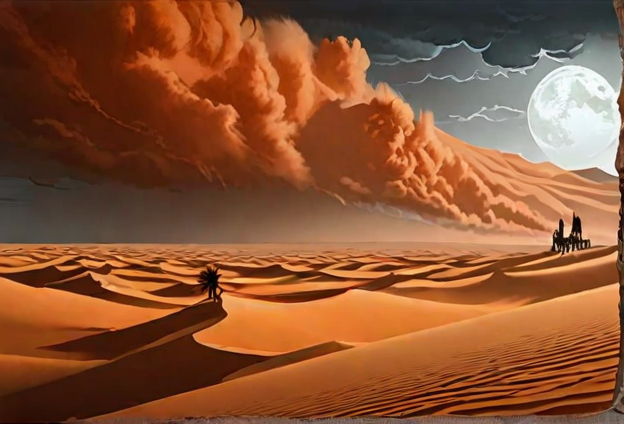Dune Sea
The Sea is dangerous, aye, same as a sea of water. Anytime you get that far from civilization, you're flirting with danger.
But the Eye watches the Sea, and if you wish to change your Fate there is no better place.
Lost among the Dunes are wonders unseen in the present age. The Lost City of the Scopulae is buried beneath the sand, its riches hidden for a thousand years. There are tales unnumbered of lost mines, hidden oases, fertile valleys, and hidden cults, and if even a tiny fraction of them are true there is more wealth than in all of Carrida.
It is also the playground of the Jann, where Efreet battles Djinn in eternal sandstorms. A fearless group can harness the power of a Dao to have their wishes granted and grasp The Hand of Fate. All it takes is the willingness to risk it all. If you don't, it's better to stay here, in Carrida, and embrace your lack of Destiny. But if you do - we ride!
Geography
Stretching 750 miles from the Shiryan River to the Estaes Ocean in the north, nearly 500 miles wide at its widest, the Dune Sea makes up the eastern stretch of the Endless Desert. The dunes extend 20 miles into the ocean as subaqueous formations for 200 miles north of the Shiryan, beginning in the river delta and covering the entire estuary.
The type of dunes varies by area, but all dune types are represented.
Subaqueous
The subaqueous dunes start from a continuous train of ripple-like dunes at the beginning of the river delta. These dunes are formed by and influence the direction of the flooding in the delta region. The estuary around the delta continues with dune formations, transforming from asymmetrical ripples to barcan dunes farther away from the shore. Two miles from shore, the dunes end at the continental shelf. The 50 miles beyond the northernmost leg of the delta are a clash between the river and the ocean currents, the ripple dunes broken up and the seabed scoured in some places.
Coastal Dunes
The east coast of Hellonde has long stretches of beaches broken up by occasional cliffs. The low stretches are dominated by coastal dunes made from wet sand pushed up by the tides, drying out, and blown in by the easterly winds. The large primary dunes serve as a break to storm surges, and the secondary dunes formed off of them transition into the inland dunes. The dunes tend to have steep eastern slopes due to erosion from waves. The high moisture content in the sand allows for much steeper sides than the drier inland dunes.
White Sands
The southwestern corner of the dune sea consists of fine white sand and salt deposits. The limestone and sandstone of the Spine Mountains is deposited in the basin during floods on the upper Shiryan, and dissolved gypsum and salt come out when it dries. This gypsum is blown across the basin and becomes ground into the fine white sand that forms into the low dunes. The gypsum sand remains trapped in the basin so the white sand is unique to the region.
Encroachment
The northern end of the dune sea is a slowly expanding area as the desert encroaches on the coast. A thin strip of land along the coast is still fertile, but the dunes encroach further yearly. The dunes roll forward with the windstorms of the storm season, and the sand chokes out vegetation. The band where the desertification is happening is about 50 miles wide, with vegetation still present on most of the dunes in the area. These coppice dunes provide nesting grounds for animals that are dying out as the land dries out.
The Waste
The bulk of the dune sea is categorized as the Waste. This area is a catch-all for the land in the Sea not included in the other areas. All types of dunes are represented, from lithified dunes scoured clean of sand, roaming dunes that change the landscape with every storm, and massive star dunes rising half a mile between peaks and valleys.
Localized Phenomena
The entirety of the Dune Sea, particularly the Waste, is subject to massive sandstorms that can stretch hundreds of miles across. These storms scour the land with driving sand and lightning strikes. The strikes often turn the sand into glass that nomadic tribes collect and sell to the caravans.
An unexpected danger in the Sea is the occurrence of the Screaming Sands. When the larger dunes - those at least 300 feet high - collapse, the sound of the avalanche can reach deafening levels, causing those within range to suffer extreme pain and hearing loss. The dunes themselves amplify and focus the crushing sound.
The Traveling Stones are enormous boulders, from 8 to 20 feet in diameter, found in various clusters through the Sea. They have not been seen to move by reliable sources, but they are found in different positions when people return to them. The nomads of the desert say that they are the homes of the Dao.
Climate
The Sea lies around the equator and has a steady hot and arid climate throughout the year. Precipitation is rare, with less than an inch falling anywhere outside of the encroachment or subaqueous regions each year.
Temperatures rarely fall below 90o in most of the Sea and often sit above 100o. In the heart of the Waste, some areas can regularly reach 120o or higher.


Comments